
Dual Checkpoint Inhibition Increases Response Rates, Adverse Effects in Melanoma
Patients with high-risk resectable melanoma treated with ipilimumab plus nivolumab had increased response rates compared with anti-PD1 monotherapy, though it was also associated with increased immune-related adverse effects.
Patients with high-risk resectable melanoma treated with dual checkpoint inhibition via ipilimumab (Yervoy) and nivolumab (Opdivo) had increased rates of pathological and radiologic responses compared with anti-PD1 monotherapy. However, the two-drug regimen was also linked with more grade 3 or 4 immune-related adverse effects (irAEs), according to findings from a pooled analysis published in JAMA Oncology.
Patients in the neoadjuvant dual checkpoint inhibitor cohort (n = 204) experienced a radiologic overall objective response (rOOR) of 50.0% vs 45.6% in the neoadjuvant anti-PD1 cohort (n = 160). Investigators noted that although the radiologic complete response (rCR) rate was higher in the combination arm vs anti-PD1 monotherapy arm (10.29% vs 5.63%), there was not a statistically significant difference between the 2 groups in terms of the odds of obtaining an rCR (OR, 1.93; 95% CI, 0.86-4.33; P = .11) or rOOR (OR, 1.19; 95% CI, 0.79-1.81; P =.41). There was also not a statistically significant difference regarding progressive disease rates (11.8% vs 15.6%) in the two cohorts, respectively (OR, 0.72; 95% CI, 0.39-1.32; P = .29).
However, when evaluated by pathologic assessment, neoadjuvant dual checkpoint inhibition (n = 205) significantly increased the odds of obtaining a pathologic CR (pCR) vs neoadjuvant anti-PD1 monotherapy (n = 173); the pCR rates were 45.36% vs 20.81%, respectively, (OR, 3.16; 95% CI, 1.99-4.99; P < .001).
“In this pooled analysis of 6 clinical trials, neoadjuvant immune checkpoint inhibitor strategies show sustained clinical responses, particularly in achieving pCR,” study authors wrote. “We found that dual checkpoint inhibitor-based regimens were associated with higher pCR odds than anti-PD1 monotherapy.”
The pooled analysis included data from patients with melanoma enrolled in a phase 2 trial (NCT02519322; n = 23), a phase 1b feasibility study (n = 20), a phase 1b study (n = 29), the phase 2 OpACIN-neo trial (NCT02977052; n = 89), a phase 2 trial (NCT02519322; n = 30), the phase 2 PRADO extension cohort of the OpACIN-neo trial (NCT02977052; n =99), and a phase 2 trial (NCT03698019; n = 313).
The study examined conventional dosing of the checkpoint inhibitor combination consisting of 3 mg/kg of ipilimumab and 1 mg/kg of nivolumab in patients, with an alternative dosing schedule of 1mg/kg of ipilimumab and 3 mg/kg of nivolumab. Subgroup analyses found that there was no statistically significant difference between key subgroups in terms of rCR, rOOR, radiographic progressive disease, or pCR.
However, when the alternative dose (n = 129) was evaluated vs anti-PD1 monotherapy (n = 182), patients had significantly higher odds of achieving a rCR (OR, 2.55; 95% CI, 1.10-5.93; P = .03) and pCR (OR, 3.87; 95% CI, 2.34-6.40; P < .001) with the combination. Additionally, increased odds of experiencing an rOOR (OR, 1.95; 95% CI, 1.01-3.77; P = .046) and pCR (OR, 2.99; 95% CI, 1.53-5.83; P < .001) were observed for patients who received the conventional dose of ipilimumab and nivolumab vs anti-PD1 monotherapy.
Further, investigators noted that there was not a statistically significant difference regarding the odds of not undergoing planned surgical resection (OR, 1.56; 95% CI, 0.72-3.39; P = .26).
Safety of Dual Checkpoint Inhibition vs Anti-PD1 Monotherapy
Patients in the combination arm had significantly higher odds of experiencing a grade 3 or 4irAE compared with those in the anti-PD1 monotherapy group (OR, 3.75; 95% CI, 2.20-6.37; P < .001); the rates were 33.82% vs 12.09%, respectively.
Additionally, grade 3 or 4 irAEs occurred at a higher rate in the conventional dosing group (56.9%) vs alternative dosing group (21.7%) of the combination arm (OR, 4.76; 95% CI, 2.38-9.52; P < .001). Patients were unable to complete neoadjuvant therapy at rates of 26.0% vs 11.6%, respectively (OR, 2.60; 95% CI, 1.14-5.95; P = .02). All patients in the conventional dosing group went on to receive surgical resection compared with 92.2% of patients in the alternative dosing group.
“Within neoadjuvant dual checkpoint inhibition [nivolumab and ipilimumab], the alternative-dose regimen was associated with a better adverse effect profile than the conventional dose regimen, with no significant efficacy differences. Translational immunologic assessments of neoadjuvant therapy are needed, and future investigations comparing immunologic outcomes of relatlimab/nivolumab combinations with ipilimumab/nivolumab will be pivotal,” study authors wrote in conclusion.
Reference
Mangla A, Lee C, Mirsky MM, et al. Neoadjuvant dual checkpoint inhibitors vs anti-PD1 therapy in high-risk resectable melanoma: a pooled analysis. JAMA Oncol. 2024:e237333. doi:10.1001/jamaoncol.2023.7333

















































































